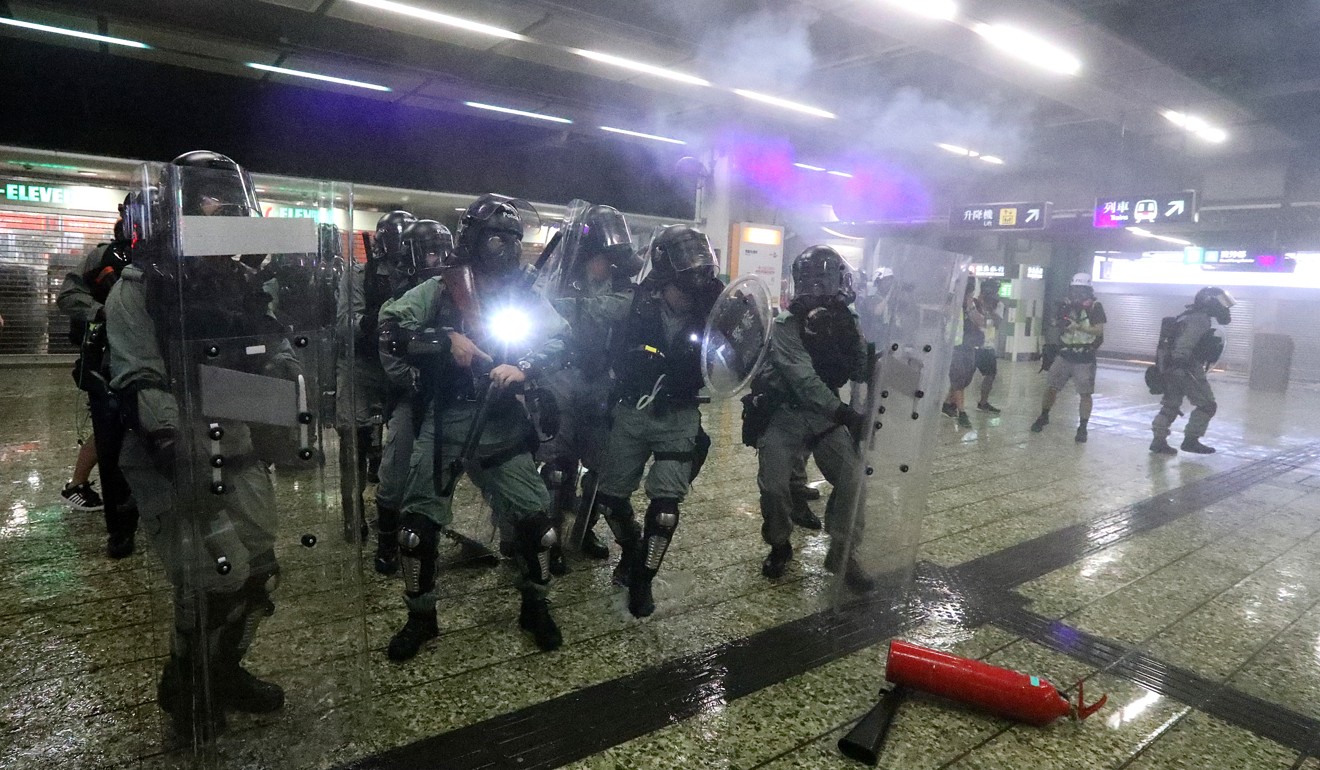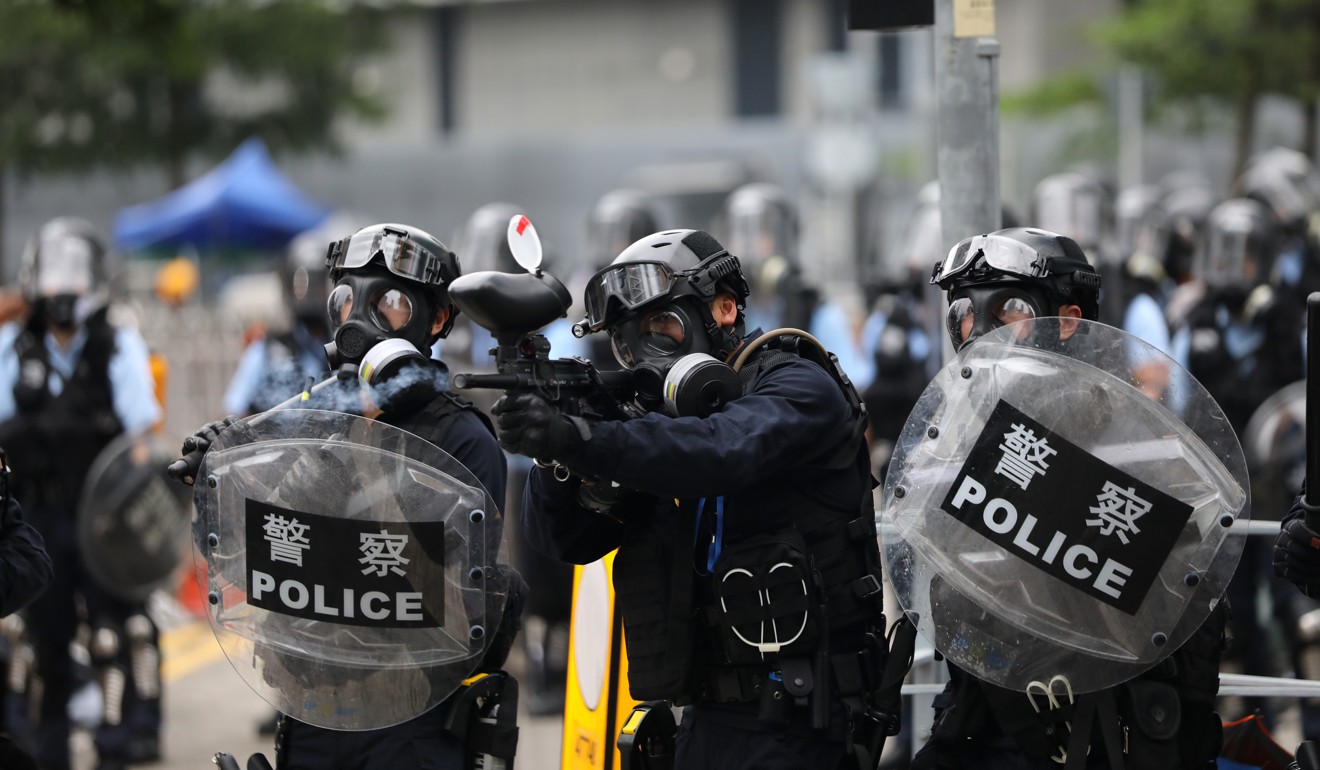
Police defend firing tear gas and pepper balls in Hong Kong MTR stations during clashes with protesters, despite condemnation by residents and rail unions
- Commuters and rail staff tell of pain and discomfort after deployment of tear gas, but police say they used ‘minimum force’ against violent protesters
- Unions describe police charge at protesters on moving escalator as ‘terrifying’
Think tank employee Thomas Yip was on the platform of Kwai Fong MTR station on Sunday night when stinging smoke flooded the area.
Spotting two elderly women, the 40-year-old went to help them, thinking police might have fired tear gas at anti-government protesters he had seen on the streets around the station in the densely populated New Territories town.
“The smoke was very thick on the platform,” he recalled on Monday. “My eyes hurt.”
Covering their mouths with their hands, Yip and the two women made their way from the elevated platform to the street-level concourse, only to be shocked to discover that the police had fired tear gas into the station.
Sunday was a day of violent clashes between police and protesters, whose demonstrations have entered their 10th week, but the Kwai Fong incident was the first time officers had fired tear gas inside a railway station.
On Hong Kong Island, there were also chaotic scenes at Tai Koo MTR station in the middle-class Quarry Bay area.
A police officer was seen firing pepper balls at a group of protesters barely a metre from him as they scrambled down an escalator. Other officers used batons to strike protesters who had been caught, subdued and pushed to the ground.
The situation was urgent and thus the police fired one round of tear gas at the station
The police action at the two stations came under fire from residents and rail unions, among others, and the MTR’s operator urged police to consider the safety of passengers and staff.
On Monday, the police defended their actions, saying they were justified considering the circumstances officers were faced with.
They said they fired tear gas into Kwai Fong station after protesters used catapults to launch ball bearings at the police, endangering the safety of officers and members of the public. Protesters at the station were also tossing what the police called “smoke cakes”, which smoulder and emit fumes.

Senior Superintendent Kong Wing-cheung from the police public relations bureau insisted that officers were using “minimum force” when they fired tear gas into the station.
“The situation was urgent and thus the police fired one round of tear gas at the station,” he said at a press briefing. “Our consideration then was to stop the protesters’ radical behaviour as soon as possible.”
The police also fired two rubber bullets inside the station.

There were dozens of protesters gathered on the surrounding streets and police began firing tear gas before 9pm to disperse them. When some protesters retreated into the station, a round of tear gas was fired into the building.
Asked why the police did not just enter the station and arrest the protesters, without using tear gas, Kong said the officers would have had to climb over the MTR gates and the protesters could have attacked them.
Flight attendant, audio technician, security guard among latest arrested
The action at Tai Koo happened about an hour later, when dozens of protesters descended on the MTR station and attempted to block a road outside it. Protesters have been using guerilla-style tactics over the past week to block roads in several districts.

The police arrived soon after, and some officers charged at protesters who were trying to go down an escalator. Video footage showed some protesters tumbling down the escalator with the officers giving chase.
Asked about the officer seen shooting pepper balls at close range, assistant police operations commissioner Mak Chin-ho said pepper ball launchers were not classified as firearms.
Pepper balls do cause irritation, he said, but firing the launchers at close range “will not have the effect most expect”. He added, however, that police will review the use of pepper balls in this incident.
Reacting to the use of tear gas at Kwai Fong station, rail operator MTR Corporation said it was “very regretful” that passengers and rail staff had been put at risk and urged the police to consider their safety.

It also condemned the violent behaviour of protesters, saying they abused fire extinguishers and damaged facilities at the station.
In the wake of Sunday’s incidents, two railway unions met the MTR management on Monday to raise concerns over staff safety.
To Kwong-yan, chairman of the MTR Corporation Staff Union, said two train drivers felt unwell after the police fired tear gas into Kwai Fong station, and one had to be hospitalised.
Hong Kong protesters raise US$1.97 million for global ad campaign
“Some union members are very angry. We think the police actions at both Kwai Fong and Tai Koo stations showed a blatant disregard for public safety,” he said.
He added that the police should have informed MTR staff before taking action at the stations.
“We are more concerned about what happened in Tai Koo station as the police fired pepper shots protesters at close range and tried to disperse them along the moving escalator. This was highly dangerous and could have caused massive casualties,” he said.

Tam Kin-chiu, vice-chairman of the pro-government Hong Kong Federation of Railway Trade Unions, said many union members were terrified by the police action at the two stations and demanded the rail operator follow up with police to ensure staff and public safety.
Icarus Wong Ho-yin, convenor of the Civil Rights Observer, an NGO, also criticised the police action at the two stations.
Rail management meet police over officers’ actions in MTR stations
He said that according to the manufacturers’ safety guidelines, tear gas should not be fired indoors.
“It’s a chemical weapon,” he said. “Apart from causing pain to your skin and eyes when fired outdoors, tear gas can also cause respiratory difficulties. It can even be lethal if fired indoors when the gas concentration is high.”
He also felt that the pepper ball launchers were powerful enough to be considered firearms.
The energy of pepper balls is between 10 and 15 joules, Wong said, adding that air guns from which a bullet of more than two joules can be discharged are defined as “arms” and cannot be used without a licence.
Additional reporting by Cannix Yau

